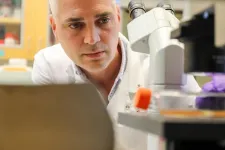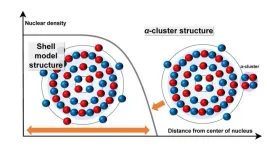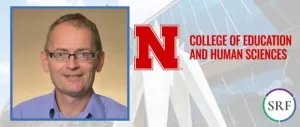(Press-News.org) COLUMBUS, Ohio – Chemists have been working to synthesize high-value materials from waste molecules for years. Now, an international collaboration of scientists is exploring ways to use electricity to streamline the process.
In their study, recently published in Nature Catalysis, researchers demonstrated that carbon dioxide, a greenhouse gas, can be converted into a type of liquid fuel called methanol in a highly efficient manner.
This process happened by taking cobalt phthalocyanine (CoPc) molecules and spreading them evenly on carbon nanotubes, graphene-like tubes that have unique electrical properties. On their surface was an electrolyte solution, which, by running an electrical current through it, allowed CoPc molecules to take electrons and use them to turn carbon dioxide into methanol.
Using a special method based on in-situ spectroscopy to visualize the chemical reaction, researchers for the first time saw those molecules convert themselves into either methanol or carbon monoxide, which is not the desired product. They found that which path the reaction takes is decided by the environment where the carbon dioxide molecule reacts.
Tuning this environment by controlling how the CoPc catalyst was distributed on the carbon nanotube surface allowed carbon dioxide to be as much as eight times more likely to produce methanol, a discovery that could increase the efficiency of other catalytic processes and have a widespread impact on other fields, said Robert Baker, co-author of the study and a professor in chemistry and biochemistry at The Ohio State University.
“When you take carbon dioxide and convert it to another product, there are many different molecules you can make,” he said. “Methanol is definitely one of the most desirable because it has such a high energy density and can be used directly as an alternative fuel.”
While transforming waste molecules into useful products isn’t a new phenomenon, until now, researchers have often been unable to watch how the reaction actually takes place, a crucial insight into being able to optimize and improve the process.
“We might empirically optimize how something works, but we don’t really have an understanding of what makes it work, or what makes one catalyst work better than another catalyst,” said Baker, who specializes in surface chemistry, the study of how chemical reactions change when they occur on the face of different objects. “These are very difficult things to answer.”
But with the help of special techniques and computer modeling, the team has come significantly closer to grasping the complex process. In this study, researchers used a new type of vibrational spectroscopy, which allowed them to see how molecules behave on the surface, said Quansong Zhu, the lead author of the study and former Ohio State Presidential Scholar whose challenging measurements were vital to the discovery.
“We could tell by their vibrational signatures that it was the same molecule sitting in two different reaction environments,” said Zhu. “We were able to correlate that one of those reaction environments was responsible for producing methanol, which is valuable liquid fuel.”
According to the study, deeper analysis also found these molecules were directly interacting with supercharged particles called cations that enhanced the process of methanol formation.
More research is needed to learn more about what else these cations enable, but such a finding is key to achieving a more efficient way to create methanol, said Baker.
“We’re seeing systems that are very important and learning things about them that have been wondered about for a long time,” said Baker. “Understanding the unique chemistry that happens at a molecular level is really important to enabling these applications.”
Besides being a low-cost fuel for vehicles like planes, cars and shipping boats, methanol produced from renewable electricity could also be utilized for heating and power generation, and to advance future chemical discoveries.
“There’s a lot of exciting things that can come next based on what we’ve learned here, and some of that we’re already starting to do together,” said Baker. “The work is ongoing.”
Co-authors include Conor L. Rooney and Hailiang Wang from Yale University, Hadar Shema and Elad Gross from Hebrew University, and Christina Zeng and Julien A. Panetier from Binghamton University. This work was supported by the National Science Foundation and the United States–Israel Binational Science Foundation (BSF) International Collaboration.
#
Contact: Robert Baker, Baker.2364@osu.edu
Written by: Tatyana Woodall, Woodall.52@osu.edu
END
South Korean researchers are revitalizing the nation's world-class cultural heritage through digital transformation. By collaborating with museums, they are bringing the rich history and culture of Korea to life using AI-based technology development.
Since 2020, the Electronics and Telecommunications Research Institute (ETRI) and the National Museum of Korea have been working together under a Ministry of Culture, Sports and Tourism R&D project to develop and demonstrate key technologies for the digital transformation of Korean cultural heritage.
The two institutions have been applying ...
When it comes to helping patients with high blood pressure get their hypertension under control, a new Tulane University study finds that pharmacists and community health workers have the best success rates.
The study, published in Circulation: Cardiovascular Quality and Outcomes, analyzed data from 100 hypertension trials around the world and compared blood pressure reductions by the type of healthcare professionals who led the interventions.
While interventions led by nurses, physicians and multiple healthcare professionals still significantly reduced blood pressure for patients, pharmacists achieved the greatest improvements, followed ...
Direct air capture was identified as one of the ‘Seven chemical separations to change the world’. This is because although carbon dioxide is the main contributor to climate change (we release ~40 billion tons into the atmosphere every year), separating carbon dioxide from air is very challenging due to its dilute concentration (~0.04%).
Prof Ian Metcalfe, Royal Academy of Engineering Chair in Emerging Technologies in the School of Engineering, Newcastle University, UK, and lead investigator states, “Dilute ...
New research led by Oregon Health & Science University reveals a promising approach to developing a universal influenza vaccine — a so-called “one and done” vaccine that confers lifetime immunity against an evolving virus.
The study, published today in the journal Nature Communications, tested an OHSU-developed vaccine platform against the virus considered most likely to trigger the next pandemic.
Researchers reported the vaccine generated a robust immune response in nonhuman primates that were exposed ...
Okinawa’s mangrove forests are home to many animal species, from crabs to kingfishers; they host a diverse ecosystem teeming with life. Among the quirkier residents living there is “Minami-Tobihaze” — the barred mudskipper. “They are fish, but they can walk and live partly on land,” says Dr. Fabienne Ziadi-Künzli from the Nonlinear and Non-equilibrium Physics Unit, who is the first author of a study on mudskipper anatomy, which was recently published in the Journal of Anatomy.
Adapting to a new life
The barred mudskipper, scientifically called Periophthalmus argentilineatus, has more than just one oddity. Their eyes ...
The world around us is made up of particles invisible to the naked eye, but physicists continue to gain insights into this mysterious realm. Findings published in Physical Review C by Osaka Metropolitan University researchers show that the nuclear structure of an atom likely changes depending on the distance the protons and neutrons are from the center of the nucleus.
OMU graduate student Maito Okada, Associate Professor Wataru Horiuchi, and Professor Naoyuki Itagaki from the Graduate School of Science compared calculations using theoretical models with existing experimental data to determine whether titanium-48, the most common isotope of titanium with 22 protons and 26 neutrons, ...
Ever hear the old adage that time flies when you’re having fun? A new study by a team of UNLV researchers suggests that there’s a lot of truth to the trope.
Many people think of their brains as being intrinsically synced to the man-made clocks on their electronic devices, counting time in very specific, minute-by-minute increments. But the study, published this month in the latest issue of the peer-reviewed Cell Press journal Current Biology, showed that our brains don’t work that way.
By analyzing changes in brain activity patterns, the research team ...
Photocatalytic hydrogen evolution from water is a key technology for achieving sustainable hydrogen production. However, the direct impact of the microscopic structure of interfacial water molecules on photocatalytic reactivity remains unexplored. In this study, the crucial roles of interfacial hydrogen bond structure and dynamics, as well as the optimal interfacial water environment for promoting H2 evolution were uncovered. These findings provide molecular-level insights that can guide the design of interfacial water conditions to enhance photocatalytic performance.
Hydrogen production via photocatalytic water splitting is a sustainable ...
Mill Valley, CA – July 10, 2024 – The SynGAP Research Fund 501(c)(3) announces a $190,636 grant, for work to be done in 2024 and 2025, to Professor Janos Zempleni, PhD of the University of Nebraska-Lincoln, to establish data required for regulatory approval for his novel treatment using an engineered version of naturally-occurring particles called exosomes. His first grant from SRF established the engineered changes required to accumulate exosomes in the brain. SRF is pleased to support the continued development of a non-invasive and targeted delivery system for therapeutics ...
DALLAS, July 18, 2024 — Diet-related diseases account for 1 in 5 deaths around the world[1] and unsustainable industrial agricultural practices threaten to compromise the health of the planet.[2] While emerging science expands our knowledge of food composition, society still understands little about the tens of thousands of components found in food.
The American Heart Association is facilitating a new research fellowship program from the Periodic Table of Food Initiative (PTFI) with support from The Rockefeller Foundation. The program, called Good Food Fellows, aims to train a new ...






